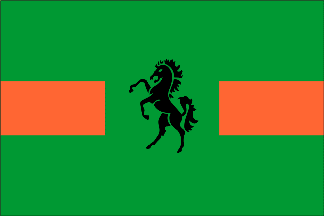qq-1.gif) image by Martin Grieve, 19 Dec 2006
image by Martin Grieve, 19 Dec 2006
Last modified: 2007-02-16 by bruce berry
Keywords: south africa | homeland | qwaqwa | horse: pony (black) |
Links: FOTW homepage |
search |
disclaimer and copyright |
write us |
mirrors
 image
by Martin Grieve, 19 Dec 2006
See also:
image
by Martin Grieve, 19 Dec 2006
See also:
Qwaqwa was a very small territory, with no enclaves, in northeastern
Orange
Free State (today's Free State), bordering
on Lesotho and Natal.
Antonio Martins, 30 May 1999
The name QwaQwa means "where we come from" and the homeland was given
internal self-government on 1 November 1974.
Bruce Berry, 01 Dec 1998
You mentioned that the name means "where we come from". We believe you
are mistaken. The name means "whiter than white". It refers to the white
sandstone cliffs in the area. We know because we grew up there!
Eric Radebe and Danie Crowther, 15 Jan 2000
Qwaqwa does indeed mean "whiter than white". The area of 655 Km2 (253
sq mi) is situated in the Drakensberg mountains and used to be known as
"Witsieshoek" (White corner - would be an easy translation), after the
farm that was originally situated there. When you look at the area from
a distance you can see all these white rock formations sticking out (I
believe it is sandstone), and there are many of them, each rock formation
is a "wit", and plenty of them would be "witsies". Furthermore the area
is situated in a corner between Freestate, KwaZulu - Natal and Lesotho
(So the complete translation would sound something like the following:
White boulders of various size sticking out of the surface in this corner
of the country. Qwaqwa is therefore more than just whiter than white, it
also refers to the multitude of these rock formations. The South Sotho
people are also refered to as Basotho, and the capital of the homeland
was called Phuthaditjhaba. The area is situated at heights of between 1 600m and over
3 000m. Originally there were 2 tribes of South Sotho people
settled there (late 1870's), the Kwena and the Tlokwa tribes, although
they lived separate the Kwena were allowed to rule the Tlokwa. In 1969
the area was combined into a single territory, and called KwaKwa (until it was realised that this spelling would make them part of a West African
sub-group), later that year it was changed to Qwaqwa, and in 1974 they
were granted self-government.
Franc M.A. Van Diest, 16 Jan 2000
I just came across your site about QwaQwa. It interesting reading about
QwaQwa from your perspective as I am from QwaQwa and used to be a journalist
there.
I got motivated to email you because there is an error made regarding the name
Witieshoek and what it means.
Qwaqwa does indeed mean "whiter than
white" and "Witsieshoek" (White corner) would be an easy
translation. The QwaQwa meaning is very close but that of Witsieshoek is
fundamentally incorrect. In fact the name Witsie comes from Wetsi
and it is the name of the leader who fought and resisted the white invaders from
the QwaQwa mountains. The whites had an impossible task of dislodging him
referred to his area as "Wetsie's post" or corner and it later took an
Afrikaans corruption to become Witsieshoek (which translates as White
corner).
Vusi Moloi, 13 Feb 2004
qq-1.gif) image by Martin Grieve, 19 Dec 2006
image by Martin Grieve, 19 Dec 2006
The Basotho pony refers to the sure-footed progress
of the people on the often difficult path of progress. The Basotho pony
is the natural means transport in this mountainous region.
QwaQwa was re-incorporated into South Africa on 27 April 1994 and is
now part of the Free State province. Since that date, the flag has not
been in use.
Bruce Berry, 01 Dec 1998
qq.jpg) scan by
Bruce Berry, 19 Dec 2006
scan by
Bruce Berry, 19 Dec 2006
By Government Notice No. 1599, published in the South African Government
Gazette (Number 3644 of 08 September 1972) it was notified that a coat of
arms had been registered for the Basotho-QwaQwa Legislative Assembly in terms of
the South African Heraldry Act (Act No. 18 of 1962). The South African State
Herald did not initially issue a formal certificate of registration in terms of
the Heraldry Act in respect of these Arms as they had been devised without
consultation of the Bureau of Heraldry. However, following a formal request from
QwaQwa, certificate number 1994 was issued on 01 September 1988.
The blazon of the coat of arms is described as:
Arms: Vert, in chief
a representation of Sentinel Peak, in base dexter a crocodile reversed and
sinister a leopard couchant gardant; behind the shield an assegai and battle axe
in saltire, all Or.
Crest: A
Basuto hat
proper.
Supporters: Two Basuto ponies
proper.
Motto: KOPANA KE MATLA
(Unity is Strength)
Following the incorporation of
Qwaqwa into South Africa on 27 April 2006, these Arms are no longer in use.
Bruce Berry, 19 Dec 2006